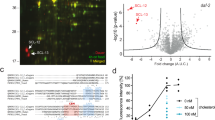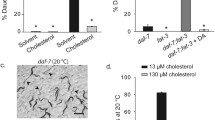Abstract
The let-767 gene encodes a protein that is similar to mammalian steroid enzymes that are responsible for the reduction of 17-beta hydroxysteroid hormones. Caenorhabditis elegans is incapable of the de novo synthesis of cholesterol. Therefore, this free-living nematode must extract cholesterol from its environment and modify it to form steroid hormones that are necessary for its survival. C. elegans is unable to survive in the absence of supplemental cholesterol, and is therefore sensitive to cholesterol limitation. We show that a mutation in let-767 results in hypersensitivity to cholesterol limitation, supporting the hypothesis that LET-767 acts on a sterol derivative. Furthermore, let-767 mutants exhibit defects in embryogenesis, female reproduction and molting. Although ecdysone is the major molting hormone in insects, there is as yet no evidence for ecdysone synthesis in C. elegans, suggesting that a different hormone is required for molting in C. elegans. Our results suggest that LET-767 modifies a sterol hormone that is required both for embryogenesis and for later stages of development.





Similar content being viewed by others
References
Asahina M, Ishihara T, Jindra M, Kohara Y, Katsura I, Hirose S (2000) The conserved nuclear receptor Ftz-F1 is required for embryogenesis, moulting and reproduction in Caenorhabditis elegans. Genes Cells 5:711–723
Barstead R, Kleiman L, Waterston R (1991) Cloning, sequencing, and mapping of an alpha-actin gene from the nematode Caenorhabditis elegans. Cell Motil Cytoskeleton 20:69–78
Bloch KE (1983) Sterol structure and membrane function. CRC Crit Rev Biochem 14:47–92
Brenner S (1974) The Genetics of Caenorhabditis elegans. Genetics 77:71–94
Carney GE, Bender M (2000) The Drosophila ecdysone receptor (EcR) gene is required maternally for normal oogenesis. Genetics 154:1203–1211
Chitwood DJ, Feldlaufer MF (1990) Ecdysteroids in axenically propagated Caenorhabditis elegans. Dev Biol 114:109–118
Edgar L, McGhee J (1986) Embryonic expression of a gut-specific esterase in Caenorhabditis elegans. Dev Biol 114:109–118
Freeman MR, Dobritsa A, Gaines P, Segraves WA, Carlson JR (1999) The dare gene: steroid hormone production, olfactory behavior, and neural degeneration in Drosophila. Development 126:4591–4602
Fukushige T, Schroeder D, Allen F, Goszczynski B, McGhee J (1996) Modulation of gene expression in the embryonic digestive tract of C. elegans. Dev Biol 178:276–288
Geissler WM, Davis DL, Wu L, Bradshaw KD, Patel S, Mendonca BB, Elliston KO, Wilson JD, Russell DW, Andersson S (1994) Male pseudohermaphroditism caused by mutations of testicular 17beta-hydroxysteroid dehydrogenase 3. Nat Genet 7:34–39
Gissendanner C, Sluder A (2000) nhr-25, the Caenorhabditis elegans ortholog of ftz-f1, is required for epidermal and somatic gonad development. Dev Biol 221:259–272
Gonczy P, et al (2000) Functional genomic analysis of cell division in C. elegans using RNAi of genes on chromosome III. Nature 408:331–336
Grant B, Hirsh D (1999) Receptor-mediated endocytosis in the Caenorhabditis elegans oocyte. Mol Biol Cell 10:4311–4326
Janke DL, Schein J, Ha T, Franz N, O'Neil N, Vatcher Gp, Stewart HI, Kuervers LM, Baillie DL, Rose AM (1997) Interpreting a sequenced genome: toward a cosmid transgenic library of Caenorhabditis elegans. Genome Res 7:974–985
Kostrouchova M, Krause M, Kostrouch Z, Rall JE (1998) CHR3: a Caenorhabditis elegans orphan nuclear hormone receptor required for proper epidermal development and molting. Development 125:1617–1626
Kostrouchova M, Krause M, Kostrouch Z, Rall JE (2001) Nuclear hormone receptor CHR3 is a critical regulator of all four larval molts of the nematode Caenorhabditis elegans. Proc Natl Acad Sci USA 98:7360–7365
Kozlova T, Thummel CS (2000) Steroid regulation of postembryonic development and reproduction in Drosophila. Trends Endocrinol Metab 11:276–280
Lewis J, Fleming J (1995) Basic culture methods. In: Epstein HF, Shakes DC (eds) Caenorhabditis elegans: modern biological analysis of an organism (Methods in cell biology, vol 48). Academic Press, San Diego, pp 3–29
Mello CC, Kramer JM, Stinchcomb D, Ambros V (1991) Efficient gene transfer in C. elegans: extrachromosomal maintenance and integration of transforming sequences. EMBO J 10:3959–3970
Merris M, Wadsworth WG, Khamrai U, Bittman R, Chitwood DJ, Lenard J (2003) Sterol effects and sites of sterol accumulation in Caenorhabditis elegans: developmental requirement for 4α-methyl sterols. J Lipid Res 44:172–181
Shim Y-H, Chun JH, Lee E-Y, Paik Y-K (2002) Role of cholesterol in germ-line development of Caenorhabditis elegans. Mol Repr Dev 61:358–366
Singh RN, Sulston JE (1978) Some observations on molting in C. elegans. Nematologica 24:63–71
Sluder AE, Mathews SW, Hough D, Yin VP, Maina CV (1999) The nuclear receptor superfamily has undergone extensive proliferation and diversification in nematodes. Genome Res 9:103–120
Stewart H, O'Neil N, Janke D, Franz N, Chamberlin H, Howell AM, Gilchrist EJ, Ha TT, Kuervers LM, Vatcher GP, Danielson JL, Baillie DL (1998) Lethal mutations defining 112 complementation groups in a 4.5-Mb sequenced region of Caenorhabditis elegans chromosome III. Mol Gen Genet 260:280–288
Sulston JE, Hodgkin J (1988) Methods. In: Wood WB (ed) The Nematode Caenorhabditis elegans. Cold Spring Harbor Laboratory Press, Cold Spring Harbor, N.Y., pp 587–606
Tsai-Morris CH, Khanum A, Tang P, Dufau ML (1999) The rat 17beta-hydroxysteroid dehydrogenase type III: molecular cloning and gonadotropin regulation. Endocrinology 140:3534–3542
Vatcher G (2000) Genetic and molecular analysis of mel-32, a serine hydroxymethyltransferase isoform in Caenorhabditis elegans. PhD Thesis, Simon Fraser University, Burnaby, B.C., Canada
Williams B, Schrank B, Huynh C, Shownkeen R, Waterston R (1992) A genetic-mapping system in Caenorhabditis elegans based on polymorphic sequence-tagged sites. Genetics 131:609–624
Yamamoto KR (1985) Steroid receptors regulated transcription of specific genes and gene networks. Annu Rev Genet 19:209–252
Yochem J, Tuck S, Greenwald I, Han M (1999) A gp330/megalin-related protein is required in the major epidermis of Caenorhabditis elegans for completion of molting. Development 126:597–606
Acknowledgements
We would like to thank Andrew Fire for providing the gfp vector and Alan Coulson for providing the cosmids. We would also like to thank the CGC for providing strains that were used in this study. This work was supported by National Science and Engineering Research Council Grant No. 31-611129
Author information
Authors and Affiliations
Corresponding author
Additional information
Communicated by C. P. Hollenberg
Rights and permissions
About this article
Cite this article
Kuervers, L.M., Jones, C.L., O'Neil, N.J. et al. The sterol modifying enzyme LET-767 is essential for growth, reproduction and development in Caenorhabditis elegans . Mol Genet Genomics 270, 121–131 (2003). https://doi.org/10.1007/s00438-003-0900-9
Received:
Accepted:
Published:
Issue Date:
DOI: https://doi.org/10.1007/s00438-003-0900-9




